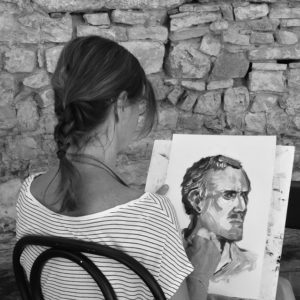Sometimes the biggest challenge for an artist is the dreaded portrait. Countless expressive souls throw away their equipment in frustration, vowing to never feel so humiliated. While this sounds melodramatic, it is all-too-common. We are here to tell you that it’s okay and that we have a few tips for you.
 Start with a Photograph
Start with a Photograph
This is as basic as it gets. Start with a photo of someone’s face. It can’t be just any photo, though. For starters, try to find a photo with a strong contrast between light and darkness. If you wish, you could try with a black and white portrait first, to get the right feeling. This is a good starting point and we can move easily from here.
Sketch First
To get the right idea about how the face looks and its lines, it is a good idea to make a rough sketch for yourself. This is going to be the skeleton on which you are going to paint later. You are not going to be following the lines closely, so don’t worry too much about it. The rest of the body comes later.
Eyes
Eyes are perfect for those that are not sure about their technique. They are the easiest to paint and they give you a good idea about the rest of your subject’s face. If your subject has any eye-wear, don’t try to make it perfect. In fact, it would be a good idea to mess it up a little, so that the focus can be on the eyes themselves.
Dark and Light
We’ve said that painting something in black and white may be a good starting point. This is because it is easier and more precise to paint with the dark tones first and then the light ones. You are allowed to blend, but we would recommend focusing on connecting your brush strokes. We are not aiming for perfection. We just need to make it better than it was.
Features
Using neutral colors to show your subject’s features allows you to experiment more with the contrast. In fact, natural colors almost guarantee you won’t mess up. After you have handled the features, you can experiment with different shades to emphasize or diminish certain areas.
 Tiles
Tiles
When painting, some artists (more specifically – alla prima artists) like to use tiles. They paint while the oil paint is still wet. This allows the artist to blend the brushstrokes with others, allowing a smooth transition between the darker and the lighter areas of the face.
Try Again
You may have expected an ancient special secret for the end. However, we have nothing left but a bit of common sense. When you complete your portrait, especially if you are disappointed in the result, try again, from the top. You are going to see a major improvement in just a couple of years. Don’t take our word for it. Artists seeking validation on social media platforms often show their old works next to the new ones.



